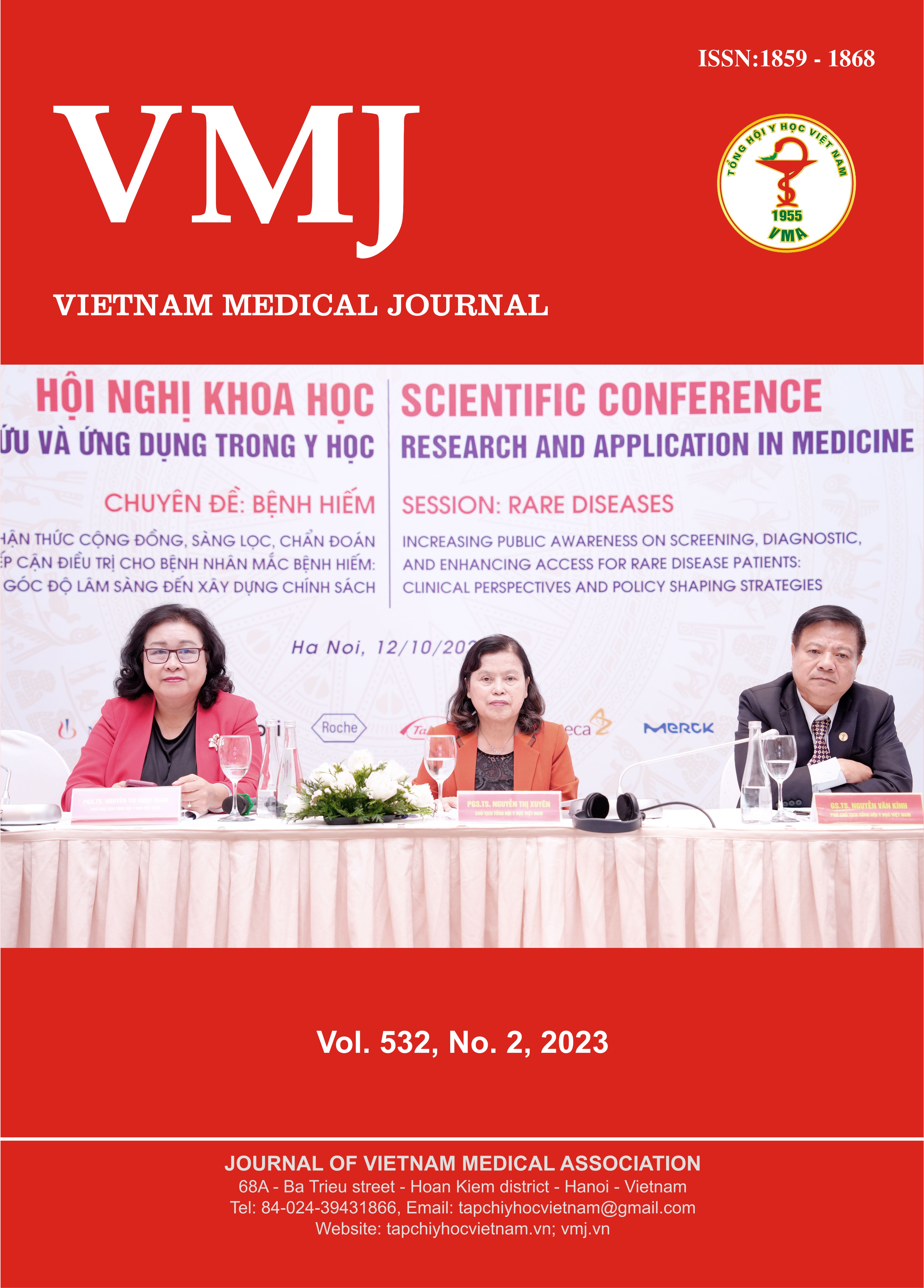PATIENT CHARACTERISTICS AND SHORT-TERM EFFECTIVENESS OF SHORT-ACTING BRONCHODILATOR COMBINATION OF SALBUTAMOL/IPRATROPIUM IN PATIENTS WITH CHRONIC OBSTRUCTION PULMONARY DISEASE (COPD): A CROSS-SECTIONAL MULTICENTER STUDY IN VIET NAM
Main Article Content
Abstract
Background and objectives: Chronic obstructive pulmonary disease (COPD) is a common disease. There have been no studies evaluating patient characteristics, management and treatment status and short-term effectiveness of the short-acting bronchodilator combination of salbutamol/ipratropium in patients being managed by a respiratory facilities in Vietnam. This is the reason for this study. Patients and methods: Prospective, descriptive, cross-sectional, multicenter study design. Patients are those who have been diagnosed with COPD (determined by FEV1/FVC value <70%) and are being managed and treated at 5 medical facilities with representative respiratory operations across the country. Convenient, random, consecutive sampling of cases being managed and guided for treatment at participating facilities over a period of 30 days. All patients in the study were asked about treatment history and exacerbations in the previous 12 months, and assessed the level of current dyspnea compared to the best condition the patient had using the VAS scale ( visual analogue scale) and performed chest X-ray, measured lung function by spirometry before and after nebulizing a dose of the short-acting bronchodilator of salbutamol/ipratropium combination. Data were recorded on a unified data collection sheet. Results and discussion: There were 183 patients in the study. The rate of using LABDs is 98.4%, ICS is 58.5%. The number of patients with frequent exacerbations is 74 (40.40%). The number of patients with at least 1 severe exacerbation hospitalized is: 60 (32.78%). The number of patients who used medication (including at least one of short-acting bronchodilators, long-acting bronchodilators, and corticosteroids) within 4 hours before examination was: 176 (96.17%). The average VAS score before medication was 4.26. The proportion of chest X-rays containing old tuberculosis lesions is 26 (14.20%). There is a significant correlation between VAS scores before, after medication and FEV1 values before, after medication and the change is ≥12% compared to predicted value. There is a high rate, 46.15% of patients with old tuberculosis lesions being treated with ICS. High rate of BMI <19 kg/m2 (27.30%). There is a positive correlation between BMI and %FEV1 pred. value, underweight (BMI <19kg/m2) was significantly associated with reduced %FEV1 pred. before medication (p<0.001). Conclusion: On 183 patients being managed and treated, it shows that there are characteristics that need to be paid attention to in terms of drug use indications, treatment effectiveness and physical characteristics expressed through BMI. With the above characteristics of symptoms, respiratory function and exacerbation, it shows that individualized management and treatment is not required to reduce symptoms. This shows that it is very necessary to add short-acting bronchodilators to treatment. The VAS scale, an intuitive, easy-to-use assessment tool that has a significant correlation with the FEV1 value, can be helpful for quickly assessing the patient's symptom control status in daily practice.
Article Details
Keywords
COPD treatment, short-acting bronchodilator, body mass index
References
2. Vietnam Medical Association. Guidelines for management and treatment of chronic obstructive pulmonary disease (COPD) Vietnam 2021. Medicine 2021.
3 Global Initiative for Chronic Obstructive Lung Disease (GOLD) report 2023. https://goldcopd.org/2023-gold 2023-2
3. Lorcan McGarvey et al. Characterisation of the frequent exacerbator phenotype in COPD patients in a large UK primary care population. Respiratory Medicine (2015) 109, 228-237
4. Terence AR Seemungal et al. Exacerbation rate, health status and mortality in COPD – a review of potential interventions. International Journal of COPD 2009:4 203–223
5. Hakan Gunen et al. The Role of TB in COPD. Poster (Chest annual meeting 2016). DOI: http://dx.doi.org/10.1016/j.chest.2016.08.956
6. Maria Montes de Oca et al. Chronic obstructive pulmonary disease and body mass index in five Latin America cities: The PLATINO study. Respiratory Medicine (2008) 102, 642–650
7. Zhenchao Wu et al. Body mass index of patients with chronic obstructive pulmonary disease is associated with pulmonary function and exacerbations: a retrospective real world research. J Thorac Dis 2018;10(8):5086-5099
8. Yilan Sun et al. BMI is associated with FEV1 decline in chronic obstructive pulmonary disease: a meta-analysis of clinical trials. Respiratory Research (2019) 20:236
9. D. Hogan et al. Nutritional status of Vietnamese outpatients with chronic obstructive pulmonary disease. Volume 30, Issue 1. February 2017. Pages 83-89.
10. Uyen Phuong Truong et al. Psychometric properties of Body Mass Index in screening malnutrition of COPD inpatients admitted at Nguyen Tri Phuong Hospital, Vietnam: a cross-sectional study. Med Pharm Res, 2021, Vol. 5, No. 3
11. Ha Thanh nguyen et al. Nutritional status, dietary intake, and health-related quality of life in outpatients with COPD. International Journal of COPD 2019:14 215–226
12. Bartolome Celli, Jørgen Vestbo. Simplifying pharmacotherapy for patients with COPD: a viewpoint. European Respiratory Journal 2023 62: 2300115; DOI: 10.1183/13993003.00115-2023.


